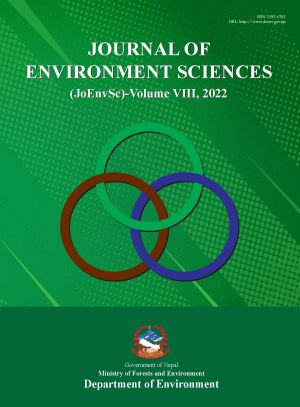Vegetation Assemblage and Carbon Stock in the Sacred Groves of Kathmandu Valley, Nepal
DOI:
https://doi.org/10.3126/jes.v8i1.53649Keywords:
Above-ground tree biomass, Below-ground tree biomass, Carbon sequestration, Importance value index, Vegetation diversityAbstract
Sacred groves (SG) play crucial roles in maintaining vegetation diversity and storing carbon. In Nepal, there is relatively little information about the carbon sequestration potential of SGs compared to other forest types. To address this research gap, this study analyzed the vegetation assemblage and carbon stock in three SGs, namely Bajrabarahi, Mhepi, and Swayambhu forests, located in the Kathmandu Valley. Systematically distributed square plots (15 m × 15 m) were used as sampling units. Above-ground tree biomass and below-ground tree biomass were estimated by using the allometric equation of trees, considering the diameter, height, and specific gravity of wood. A total of 479 individuals of woody species belonging to 37 species were recorded from the three SGs. Species diversity and species richness were relatively higher in Swayambhu SG. Based on the importance value index, Celtis australis, Schimawallichii, and Neolitseacuipala were dominant in Mhepi, Swayambhu, and Bajrabarahi SGs, respectively. Total biomass and carbon stock were highest in the Bajrabarahi Forest and lowest in the Swayambhu Forest. The average biomass and carbon stock in the three urban SGs were approximately 405 ton/ha and 191 ton/ha, respectively. The findings of the present study suggested that maintaining vegetation assemblage, biomass, and carbon stock in SGs might have important contributions to sequestering carbon, conserving biodiversity, and enhancing the aesthetic values of the religious areas.




